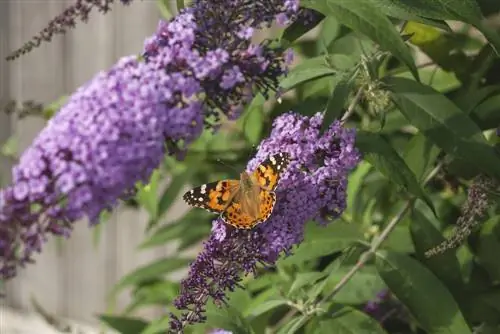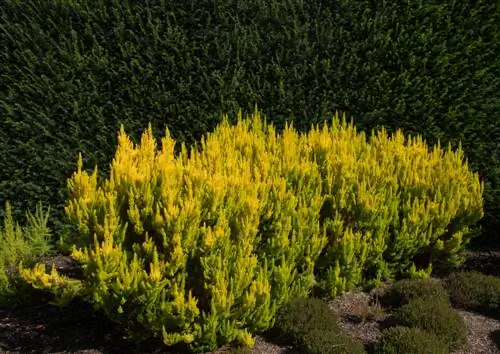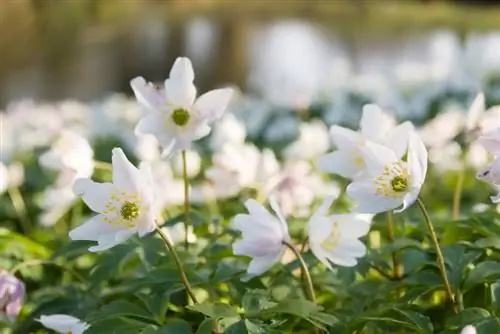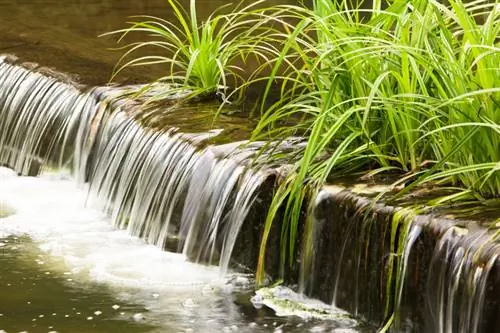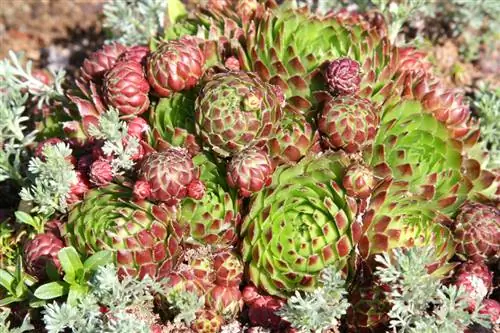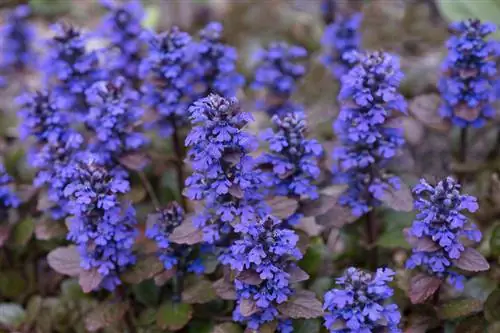- Author admin [email protected].
- Public 2023-12-25 17:45.
- Last modified 2025-06-01 06:02.
The buddleia (bot. Buddleja) is also known as butterfly lilac and has this name for good reason: the shrub, which blooms beautifully in violet or blue tones and has a sweet scent, attracts countless butterflies that feast on its nectar. The better the buddleia is cared for, the more lush the flowers will be. By the way, the species looks very similar to the widespread lilac, but is not related to it.

Origin and distribution
There are around 100 different species of buddleia (bot. Buddleja), which are part of the figwort family (Scrophlariacae). They are subshrubs or shrubs that can be summer or winter green. There are also some evergreen species. The genus is primarily native to the tropical to subtropical regions of North and South America as well as Africa and Asia, where most species thrive in sunny, dry and hot locations. Despite the similarity and the name, the buddleia is not related to the common lilac (bot. Syringa vulgaris), because from a scientific point of view it belongs to the olive family (Oleaceae).
Usage
The relatively undemanding buddleia fits wonderfully both as a solitary plant and in a group planting in full sun garden locations with poor, gravelly soils. The shrub cuts a fine figure in colorful summer flower and perennial beds as well as for greening dry embankments. The plant is also very suitable as a border in front gardens and along garden paths and can easily be used for hedge planting. Buddleia is also popular in Mediterranean-style gardens, for example in combination with other plants from the Mediterranean region such as lavender, thyme, sage, etc. Together with other perennials that are popular with butterflies, such as asters or sedum, you create a busy oasis for the small butterflies.
The species Buddleja davidii, of which there are numerous, colorful varieties, is particularly popular for the garden. The alternate or narrow-leaved buddleia (Buddleja alternifolia) is also very suitable for garden cultivation, whereas the rare yellow buddleia (Buddleja x weyeriana) should only be planted in regions with mild climates due to its lack of frost hardiness. However, all species are also ideal for keeping in containers.
Appearance and growth
The species Buddleja davidii is particularly suitable for the Central European climate zone with its sometimes harsh and cold winters, of which there are numerous variants with different growth forms, heights and also flower colors. The bushes grow either broadly upright to stocky - depending on the variety - and develop a funnel-shaped, loosely structured crown with strong main shoots. The flowers are located on the loose side branches, which often bend slightly under this weight. On average, these varieties of buddleia grow up to two meters high, although there are also tall variants with a height of up to four meters. Buddleja davidii is one of the wintergreen species because the gray-green foliage often remains on the shoots until frost and only dies off with the first frost. In winter, the above-ground parts of the plant can freeze back, but the fast-growing shrub sprouts again in spring and quickly reaches its previous height.
Flowers and flowering time
In contrast to the common lilac, the buddleia does not bloom in spring, but only from July. Its elongated, large and strongly fragrant flower spikes are usually located at the ends of the side and main shoots and are so heavy that the branches overhang. Many varieties bloom well into autumn and delight the viewer with a lush splendor of white, pink, red and purple in various tones. After pollination - and as long as the withered shoots are not cut away - capsule fruits develop that contain many tiny and winged seeds.
Toxicity
What tastes so good to butterflies is unfortunately poisonous to people and pets. The popular species Buddleja davidii in particular contains toxic saponins and glycosides such as catapol and aucubin in all parts of the plant, but mainly in the leaves and seeds. If children or pets try the shrub, symptoms of poisoning such as headaches and nausea, but also cramps, vomiting and diarrhea can occur. Those affected should drink plenty of water and consult a doctor or veterinarian immediately.
The cuttings that occur on a large scale in spring are not suitable for feeding to large or small animals such as horses, cattle or guinea pigs, rabbits or turtles. However, you can add he althy plant parts to the compost without hesitation.
Which location is suitable?
As in its natural habitats, the buddleia feels most comfortable in a sunny and warm location. If necessary, a spot in light partial shade will also work, as long as the plant gets at least a few hours of sun there in the morning and evening. However, the location should not be shady: the buddleia does not feel comfortable here, it will stop growing and will not produce any flowers.read more
Substrate / Soil
Plant the buddleia in loose, well-drained and only moderately nutrient-rich soil, which can also be gravelly and poor. When planting, amend the soil with mature compost to make it easier for the shrub to grow in its new location. Buddleia, on the other hand, does not like heavy, loamy soils that tend to become waterlogged. If necessary, look for another, more suitable location for the plant or improve the soil significantly with compost and gravel or coarse sand. In this case, drainage is also recommended so that waterlogging does not occur in the first place.
pot culture
In particular, the frost-sensitive varieties such as the ball buddleia (Buddleja globosa) and the yellow buddleia (Buddleja x weyeriana) should not be planted in the garden bed outside of mild winter regions, but rather cultivated in a sufficiently large container. Other species - Buddleja davidii, for example - are also very suitable for keeping in containers, provided there is enough space.
Special, small varieties are particularly suitable for this. Variants like 'Purple Emperor' or 'Summer Lounge' only grow to around one and a half meters high and therefore don't need quite as much space - this fact is not unimportant, especially on a cramped balcony. Choose the largest and deepest possible planter made from a natural material such as clay or ceramic so that the roots have enough space and do not heat up in the summer heat. Clay pots in particular ensure air exchange and thus keep the roots of the plant cool.
As a substrate, use commercially available potting soil, which you mix with gravel and expanded clay. This increases the permeability of the substrate, although you must of course not forget the basic drainage in the pot. The bottom of the pot always needs a drainage hole through which excess water can flow into the planter orthe coaster flows. Water the plant regularly so that it neither dries out nor is constantly in wet substrate. In addition, regular fertilization is very important when kept in a container, as the plant cannot take care of itself. Therefore, provide them with a liquid fertilizer for container plants every two weeks, but only during the growing season between April and August. Outside this time, only watering is carried out, but no more fertilization.
Overwinter the buddleia in a cool and bright place, but frost-free, in an unheated interior.
Planting buddleia correctly
Since buddleia is usually grown and sold in containers, you should definitely plant the shrub just as deep or high in the garden as it was in the planter. If necessary, mark the spot with a pen. Otherwise, when planting the buddleia, proceed in exactly the same way as you would any other plant:
- Dig a planting hole that is twice as wide and deep as the root ball.
- In the meantime, immerse the root ball in a bucket of water.
- There it can soak up water, which in turn helps it grow.
- If necessary, improve the garden soil with sand/gravel.
- If necessary, apply a drainage layer of gravel about five centimeters thick on the bottom of the hole.
- Mix the excavated soil with plenty of ripe compost.
- Place the buddleia in the planting hole and fill in the soil.
- Tread carefully and water the root area thoroughly.
If desired, you can also mulch the root area with bark mulch or another suitable material.read more
What is the best time to plant?
Plant the buddleia - including the hardy species and varieties - if possible after the ice saints in spring, when the ground has already warmed up a little and the risk of night frosts has been averted. The plant now has a few months to grow in its new location in the garden until the first winter comes and the above-ground parts of the plant may freeze back.
The correct planting distance
The popular varieties of Buddleja davidii in particular can grow to quite considerable sizes with a growth height of up to 300 centimeters and a growth width of up to 200 centimeters, especially since the shrub is also quite fast-growing. For solitary plants, maintain a planting distance of around 150 centimeters, but for hedge or group planting a distance of between 80 and 100 centimeters is sufficient. Smaller species, on the other hand, require significantly less space.
By the way, the buddleia is very easy to plant under, as the lower part of the bush often remains bare. Annual summer flowers, but also short perennials, are particularly suitable for this.read more
How do I transplant correctly?
If the buddleia needs to be transplanted to a new location, this is possible without any problems. However, postpone this measure to May or early autumn, as moving in the middle of the growing season can quickly lead to problems due to the inevitable loss of roots. The best way to do this is as follows:
- Cut the bush back sharply by at least a third.
- Tie the remaining shoots together at the top.
- Dig a deep trench around the bush with a sharp spade.
- Use a digging fork to loosen the root ball in the soil.
- Lift it out along with the plant.
- Replant the shrub in its new location.
- Mix the excavated material with plenty of compost.
Water the newly transplanted buddleia abundantly to make it easier for it to grow. You should also water the plant more in the next few weeks.read more
Watering buddleia
Freshly planted buddleia should be regularly supplied with water so that it takes root better. This is especially true in the summer months when it is hot and dry. Specimens cultivated in pots also rely on a regular supply of water because they cannot provide for themselves. However, waterlogging should not occur as this will result in root rot. However, older buddleia that is already well established in its location in the garden only needs to be watered rarely, for example during a long dry summer period.
Unlike many other plants, you can easily supply Buddleja with hard water from the tap, as the plants prefer this.
Fertilize buddleia properly
The buddleia is also pleasantly undemanding when it comes to nutrient supply: you should only add a generous shovel of compost and possibly a handful of horn shavings to it when planting and after pruning to stimulate subsequent new growth. Shrubs only cultivated in containers should be fertilized every two weeks during the growing season with a liquid container plant fertilizer that is more phosphorous than nitrogen-based.read more
Cut buddleia correctly
There are many good reasons to cut back buddleia regularly. In particular, spent shoots should be removed regularly to keep the shrub blooming continuously. Once he puts his energy into the formation of seeds, the lush flowers are over.
Further pruning measures and, above all, their timing depend heavily on the type and variety of buddleia. The frequently cultivated Buddleja davidii, for example, only produces flowers on this year's shoots and is therefore often put "on the stick" in spring, i.e. H. cut back to a height of 20 to 30 centimeters above the ground. This measure is particularly necessary if the above-ground parts of the plant have frozen back as a result of a cold winter and the shrub needs to sprout again. However, to prevent the buddleia from blooming too late, you should prune it in April at the latest, or even better during a mild period in March.
Other types of buddleia may not be cut back so much. For example, Buddleja alternifolia only receives a thinning cut, which is carried out after flowering in autumn. Apart from removing shoots that are too close together or have dried out, you can also shape the shrub a little, but you should not cut off any of this year's shoots: the Chinese buddleia will bloom on these the following year.read more
Propagate buddleia
Although you can also propagate buddleia using (self-collected) seeds, this type of propagation is not suitable for pure offspring. If you value pure propagation without any surprise effect, you should cut cuttings in the summer, plant saplings or obtain cuttings from the cuttings. Classic propagation from cuttings quickly shows success and works best according to this scheme:
- Cut semi-woody shoots without flowers in June / July.
- These should be about ten to 15 centimeters long.
- Completely woody branches are not suitable, but can be used as cuttings.
- Leave two to three leaves at the top of each cutting, remove the rest.
- Cut these leaves in half to reduce the rate of evaporation.
- Plant the cuttings individually in small pots with growing medium.
- Always keep the substrate slightly moist, but not wet.
- Put a cut PET bottle or plastic bag over the plant.
- Both improvise a mini greenhouse and must therefore be translucent.
- Place the pot in a warm and bright, but not directly sunny place.
- Air the mini greenhouse daily.
As soon as the cuttings start to develop new shoots, they have developed strong roots and the protective covering can be removed. However, do not put these young plants in the garden yet, but rather keep them frost-free in a cool and bright interior for the first winter.read more
Diseases and pests
The buddleia is a very robust plant that rarely gets sick or attacked by pests. Most problems occur as a result of improper care, especially if the shrub has been overwatered. Yellow leaves often indicate overwatering, and the shoots of the affected plant soon wilt and dry out despite seemingly sufficient water supply.
Downy mildew, a fungal disease, can become a problem, especially in wet summers. Yellow spots on the upper sides of the leaves and a grayish-white fungal growth on the undersides are a clear indication of this common disease. Cut off the affected shoots generously and dispose of them with household waste, but under no circumstances in the compost. In addition, the diseased plant should be sprayed with a decoction of field horsetail broth, as this biological remedy, which is easy to make yourself, helps reliably against fungal diseases.
Buddleja davidii in particular often freezes back during cold winter months, but this is usually not a problem - at least as long as the roots of the shrub are not affected. In autumn, cover the root area generously with a thick layer of leaves and bark mulch to keep frost away and cut the buddleia back heavily in spring. It will sprout again reliably and very quickly.
Of course, pests don't stop at an already weakened buddleia. Mainly aphids, but also gall mites and leaf miners cause problems for the shrub. Prevent an infestation by nurturing and caring for beneficial insects in your garden and offering them comfortable shelter in a conveniently located insect hotel.
Tip
Young buddleia still need winter protection, especially in the first three years. Afterwards they are usually sufficiently hardened to withstand temperatures of up to minus 15 °C.
Species and varieties
Of the numerous species of the Buddleja genus, B. davidii and the Chinese or alternate buddleia, B. alternifolia, are mainly cultivated in this country. The variety of varieties is particularly high for Buddleja davidii:
- ‘Adonis Blue’: beautiful, dark blue flower spikes
- ‘African Queen’: purple to lilac-blue flower spikes
- ‘Black Knight’: very dark flower color from purple to dark violet
- 'Cardinal': strong dark pink to purple flower color
- ‘Empire Blue’: light, blue-violet flower color
- 'Pink Delight': beautiful, light pink flower color
- 'Purple Emperor': dark, purple-red flower spikes
- ‘Summer Beauty’: pretty, purple-violet flower color
- ‘White Bouquet’: strong, pure white flower spikes
The yellow buddleia (Buddleja x weyeriana) comes with the variety 'Sungold', which has a particularly striking, light yellow flower color.

